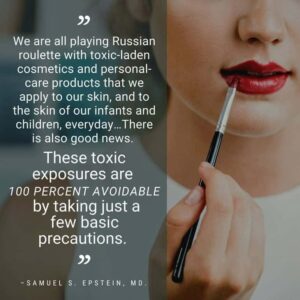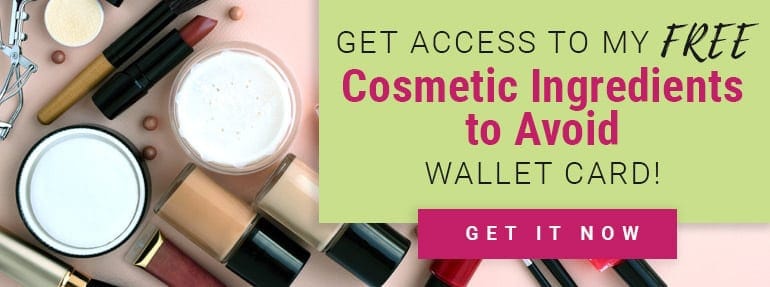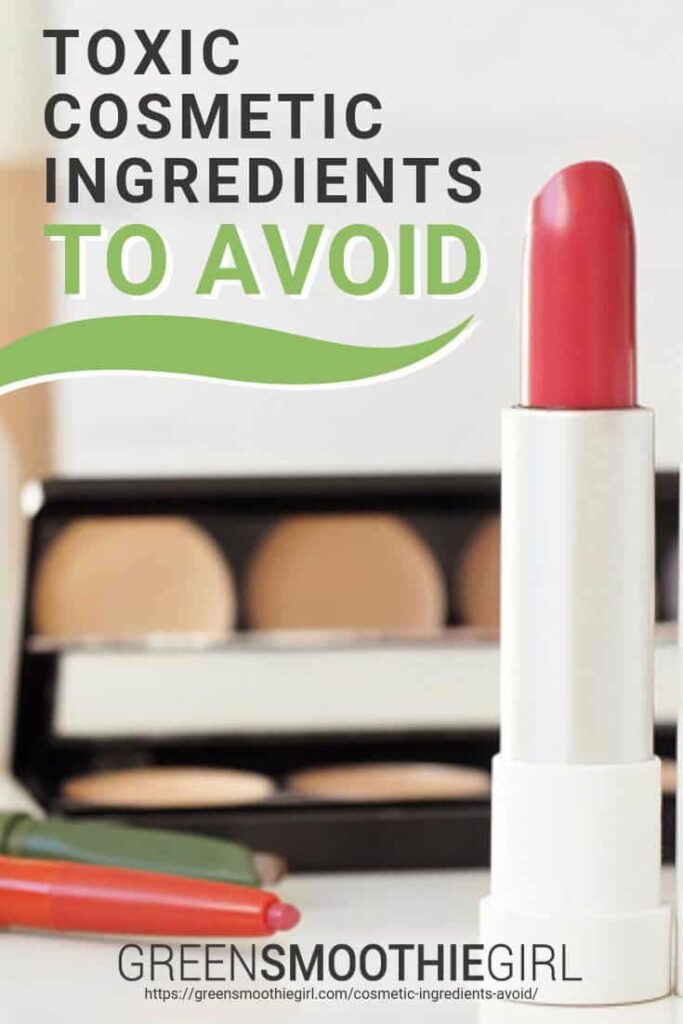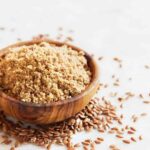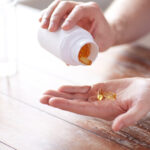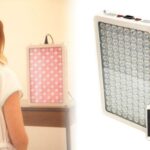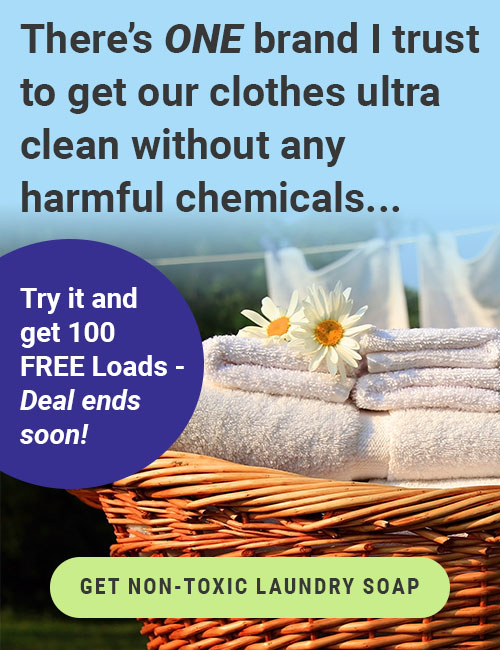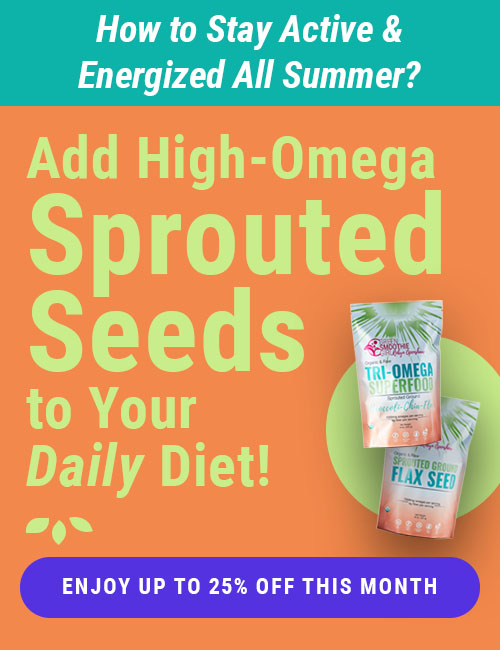Toxic Cosmetic Ingredients To Avoid

What you put into your body has a tremendous impact on your health, but it’s important to remember that what you put on your body is just as essential.
Skin, the largest organ of the body, readily absorbs the ingredients from moisturizers, lotions, perfumes, color cosmetics, and hair treatments, which find their way to the bloodstream and lymphatic system through the skin’s pores. They also make their way into cells, hair follicles and sweat ducts.
In this post:
The chemicals and other toxic ingredients in cosmetics have been linked to infertility, respiratory distress, and even cancer.1 It is estimated that the average woman absorbs approximately 4.5 pounds of chemicals from makeup and toiletries every year!2
The good news? You can avoid these toxic ingredients by choosing natural, organic personal care products. Keep in mind that some makeup and skincare products claiming to be “natural” are actually full of problematic chemical ingredients, since the word “natural” is unregulated (and therefore meaningless).
Let’s take a look at the most commonly used cosmetic ingredients to avoid, and then share the healthy alternatives.
What Cosmetic Ingredients Should You Avoid?
1. Mineral Oil
Minerals and oil—what could be so bad about that combination? Plenty, it turns out. This deceptive ingredient is found in eyeshadow, lipstick, blush, concealer, moisturizers and a host of other personal care products. Believe it or not, mineral oil is a byproduct of the distillation of gasoline from crude oil.
You may know it as petrolatum or petroleum jelly. The EU classifies petrolatum as a carcinogen and limits its use in cosmetics.3
It is included in California’s Proposition 65—chemicals known to to cause cancer or reproductive toxicity.
Your skin is your body’s largest detoxifying organ--but because of mineral oil’s thick consistency, it blocks the skin’s pores, contributing to toxic exposure for millions of cells and ultimately leading to increased risk for numerous chronic diseases.
2. Talc
It seems innocuous enough--after all, it’s the major ingredient in “baby powder.” But don’t be fooled by the mild name: it’s very similar to carcinogenic asbestos, and it’s toxic to breathe.
Women who use it in the genital area, a common use for baby powder, increase their risk of ovarian cancer three to four fold! Talc is well known since the 1970s to cause cancerous tumors.
Still, the FDA allows it in antacids, garden pesticides, flea and tick powders, deodorants, soap, paint, paper, and all kinds of cosmetic powders.
If you use a pressed or loose facial powder, use a natural, non-toxic, talc-free mineral powder.
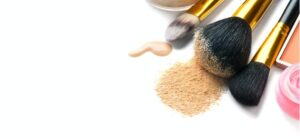
Pay attention to the ingredients in your chosen makeup products, including powders and liquid foundations.
3. Alcohol
Not only is alcohol drying and irritating, but it’s a solvent that strips away your skin’s natural protections, allowing bacteria, viruses, and fungus to gain a foothold. It is a petroleum derivative and causes premature aging of the skin and destroys the gastrointestinal barrier.
4. Titanium Dioxide, Zinc Oxide, Iron Oxide
These are the alternative ingredients in “bare minerals,” the newest trend in beauty care products, particularly powders and foundation.
Marketing strategy is to say that they are “just minerals,” which your skin needs, so they are good for you. I am not convinced this is true and believe that some of the “minerals” are in fact toxic heavy metals. But they are probably likely to be far less toxic than the mineral oil liquid foundations found in drugstores (and even much more expensive) makeup, which contain propylene glycol, mineral oil, and many other harmful chemicals.
At high exposure levels, titanium dioxide and zinc and iron oxides led to slightly higher incidence of lung cancer in rats, but manufacturers point to them being “not classifiable as a human carcinogen.”
I am not particularly excited about them, but if you’re going to wear powder and foundation, they are likely preferable to petroleum products. They are also the main ingredient in sunscreens, even those sold in health food stores touted as safer.
5. Sunscreen
Wearing sunscreen may be associated with far more cancer risk than being in the sun. The Environmental Working Group released a study in 2007 that indicated 84% of sunscreens either provide inadequate protection or contain harmful chemicals. You can search on any product at EWG.org and learn its toxicity level as well as lots of “green” alternatives.
6. Parabens
These are one of the most widely used preservatives. In fact, about 90 percent of cosmetics contain this chemical. Dr. Samuel S. Epstein, author of Toxic Beauty, states that women are exposed to 50 mg of parabens per day from cosmetics.4
They have been shown to mimic estrogen and have been detected in human breast cancer tissues. They have also been linked to skin cancer and decreased sperm counts.
7. Phthalates
These chemicals are found just about everywhere in our society. They are used in plastics to make them flexible, in nail polishes to reduce cracking, and in hair sprays to minimize stiffness.
They are also found in cosmetics where they frequently hide under the term “fragrance” or “parfum.” Unfortunately, U.S. federal law does not require cosmetic companies to list what they use as “fragrances” because it is deemed a trade secret.
Environmental Research reported on a study whose aim was to determine the amount of phthalates in cosmetics and personal care products. Of the 252 products analyzed, 103 contained these chemicals with the highest levels found in fragrances.5
In addition to fragrance, you will find them under the names DEP, DBP and DEHP.
These chemicals have been linked to endocrine disruption—altering hormone levels which can lead to infertility and cancer. DBP has been shown to cause an increase in the number of breast tumor cells and make anti-estrogen treatments less effective against tumors.6
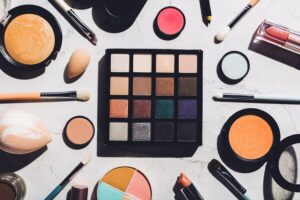
Some ingredients commonly found in makeup are linked to serious health problems.
8. Lead
In 1978, the federal government banned the manufacturing of lead-based house paint. Why? Because even small amounts of this heavy metal have been shown to affect IQ and the ability to pay attention in children.
In adults, it has been linked to reduced fertility, kidney damage and high blood pressure.7
A report from the FDA showed trace amounts of lead in 400 lipsticks.
According to Dr. Mark Mitchell, co-chair of the environmental health task force for the National Medical Association, “Lead builds up in the body over time and lead-containing lipstick applied several times a day, every day, can add up to significant exposure levels.”8
How does lead find its way into lipstick? Color additives are the most common source. And consider that you end up swallowing some of your lipstick!
9. Butylated Compounds (BHA & BHT)
You’ve probably noticed these preservatives on many food labels. They are found in chips and baked goods as well as butter, cereal, preserved meats and beer.
They are also commonly used in makeup, including foundations, eyeshadows, blushes and lipsticks.
The National Institutes of Health has defined these preservatives as “reasonably anticipated to be a human carcinogen,” and yet the FDA has determined them to be generally safe.9
These compounds have been shown to accumulate in human tissue over time. Avoiding BHA and BHT in both food and skincare products would be wise.
10. Quaternium-15
This preservative is commonly used in cosmetics as a means of increasing shelf life. Unfortunately, while keeping bacteria at bay, it also releases small amounts of formaldehyde—a known carcinogen. While the main risk is through inhalation, laboratory studies demonstrate that it is also absorbed through the skin.10
Other formaldehyde-releasing chemicals commonly found in cosmetics include DMDM hydantoin, diazolidinyl and imidazolidinyl urea, methenamine and sodium hydroxymethylglycinate, BHUT and bronopol.
In Japan and Sweden, these chemicals are banned from use in cosmetics.
The EU has declared that these preservatives must be identified on cosmetic labels and include “contains formaldehyde” if the concentration exceeds .05 percent.
Unfortunately, in the U.S., we have very few restrictions regarding these or any of the chemicals featured in this article, even when concentrations hit up to .5 percent (as they do in many nail polishes).
These compounds are also commonly found in mascara and eyeliner.
11. Polyethylene glycols (PEGs)
These commonly used petroleum-based compounds are added to cosmetics in order to make them creamier. They are, unfortunately, often contaminated with 1,4-dioxane and ethylene oxide, chemicals classified by the International Agency for Research on Cancer as a known human carcinogen. PEGs are also harmful to the nervous system.
Researchers conducted a study on 100 personal care products marketed as “natural” or “organic.” 1,4-dioxane was found in almost half of these products.11
These chemicals can also be found in spray-on oven cleaners and, in Canada, have been prohibited on Health Canada’s Cosmetic Ingredient Hotlist.
I’ve banned the use of spray-on oven cleaners in my home--I don’t want to be applying one of its ingredients to my face.
Ideally, if you can’t pronounce it or spell it without a dictionary, don’t put it on your skin or in your mouth.
What are Healthy Cosmetic Alternatives?
It is said that for every disease, there is a cure that can be found in nature. The same can be said for the chemicals that are used as preservatives, fragrances and processing in cosmetics.
Don’t be fooled by cosmetic makers that tout themselves as “natural” only to read ingredients that sound like a science experiment. “Natural” ingredients are natural—meaning they come from nature.
Common alternatives to toxic preservatives include rosemary, Vitamin E, honey, tea tree oil, grapefruit seed extract, and aspen bark extract.
In order to avoid lead contamination, look for products that use natural pigments.
Replace alcohol astringents with a natural astringent such as witch hazel or raw apple cider vinegar.
Avoid fragrances by looking for products that use essential oils instead.
And steer clear of mineral oil-laden products by looking for natural alternatives such as aloe vera, argan oil, mango seed oil, apricot kernel oil, and avocado oil, to name a few.
I have personally used coconut oil as a moisturizer and hair treatment for years.
What skin really needs is clean air, natural oils, exfoliation, light skin brushing, and rest--not inorganic, ground-up minerals. Let your skin breathe most of the time, rather than wearing pore-clogging foundation every day.
If you don’t like the appearance of your skin now, consider that as you let it breathe with clean air, makeup-free days, oxygenating exercise, regular sessions in an infrared sauna, vegetable juices and green smoothies, a whole foods diet, and an organic coconut oil as a moisturizer, you’re making every effort to slow aging of your skin.
I’ve just touched on the surface of the many chemicals and compounds found in cosmetics. In order to help you check your personal care items for cosmetic ingredients to avoid, I’ve put together a free wallet-sized card that you can take with you when you shop.
It lists over 30 of the most common toxic cosmetic ingredients to avoid. Print it, cut it out, and put it in your wallet, to consult anytime you shop for personal-care items and cosmetics! I hope this card makes it easier for you to make better choices for healthier skin and decreased disease risk.
Read next: Which brand of cosmetics does Robyn use? The kind she can eat!

Disclosure: This post may contain affiliate links that help support the GSG mission without costing you extra. I recommend only companies and products that I use myself.
Sources
- Rattue, Grace. Rising Infertility and Cancer Rates Possibly Linked to Pharmaceuticals and Household Chemicals. Medical News Today. 05/2012. https://www.medicalnewstoday.com/articles/245485.php
- Macrae, Fiona. Women absorb up to 5 lbs of damaging chemicals a year thanks to beauty products. Daily Mail. 06/2007. http://www.dailymail.co.uk/health/article-462997/Women-absorb-5lbs-damaging-chemicals-year-thanks-beauty-products.html
- European Commission. Regulation (EC) 1272/2008, Annex VI, Table 3.2. Sep 2009
- Epstein, S. with Fitzgerald, R. Toxic Beauty. Dallas: BenBella Books, 2009
- Koniecki, D et al. Phthalates in cosmetic and personal care products: concentrations and possible dermal exposure. Environmental Research. 04/2012. https://www.ncbi.nlm.nih.gov/pubmed/21315328
- Kim IY et al. Phthalates inhibit tamoxifen-induced apoptosis in MCF-7 human breast cancer cells. Journal of Toxicology and Environmental Health. 12/2004. https://www.ncbi.nlm.nih.gov/pubmed/15513900.
- Lead. Centers for Disease Control and Prevention. https://www.cdc.gov/lead-prevention/about/index.html
- Poisonous puckers? Top 10 lead-filled lipsticks. CBS News. https://www.cbsnews.com/pictures/poisonous-puckers-top-10-lead-filled-lipsticks/
- Report on Carcinogens, Fourteenth Edition. Butylated Hydroxyanisole. https://ntp.niehs.nih.gov/ntp/roc/content/profiles/butylatedhydroxyanisole.pdf
- Bartnik FG, Gloxhuber C, Zimmermann V. “Percutaneous absorption of formaldehyde in rats.” Toxicol Lett.25, 2 (1985):167-72
- OCA (Organic Consumer Association). 2008. Consumer alert. Cancer-causing 1,4-dioxane found in personal care products misleadingly branded as natural and organic.
- Houlihan, Jane et al. Body Burden—The Pollution in People. Research Gate. 01/2016. https://www.researchgate.net/publication/242521536_BodyBurden_The_Pollution_in_People
Posted in: Detox, Eco Friendly Living, Lifestyle, Natural Products



